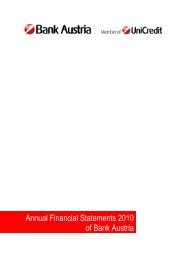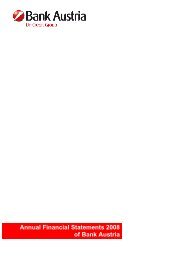Annual Financial Statements 2011 of Bank Austria
Annual Financial Statements 2011 of Bank Austria
Annual Financial Statements 2011 of Bank Austria
Create successful ePaper yourself
Turn your PDF publications into a flip-book with our unique Google optimized e-Paper software.
Management Report<br />
Management Report (CONTINUED)<br />
Private <strong>Bank</strong>ing<br />
(€ m) <strong>2011</strong> 2010 CHAngE<br />
Operating income 149 140 +9 +6.7%<br />
Operating costs –100 –101 +1 –0.5%<br />
Operating pr<strong>of</strong>it 49 39 +10 +25.3%<br />
Net write-downs <strong>of</strong> loans –4 –2 –2 n.m.<br />
Net operating pr<strong>of</strong>it 45 37 +8 +21.5%<br />
Pr<strong>of</strong>it before tax 47 39 +8 +21.4%<br />
Total financial assets (avg.) 16,995 16,514 +481 +2.9%<br />
Loans to customers (avg.) 389 369 +19 +5.2%<br />
Risk-weighted assets (avg.) 484 535 –50 – 9.4%<br />
Average equity 131 123 +9 +7.3%<br />
n.m. = not meaningful<br />
With its two well-known brands – <strong>Bank</strong> <strong>Austria</strong> Private <strong>Bank</strong>ing, the<br />
private banking operations <strong>of</strong> a major bank, and Schoellerbank, a traditional<br />
private banking institution – the Private <strong>Bank</strong>ing Division is<br />
the third pillar <strong>of</strong> <strong>Austria</strong>n customer business. In Private <strong>Bank</strong>ing, too,<br />
the range <strong>of</strong> services covers all banking services, from account management<br />
to financing needs. Based on an exclusive advisory strategy,<br />
these services are tailored to the client’s specific requirements. With<br />
a presence in 25 locations throughout <strong>Austria</strong>, the Division’s 556<br />
employees serve the top segment <strong>of</strong> private customers. With about<br />
€ 17 bn in client assets (total financial assets at the end <strong>of</strong> <strong>2011</strong>:<br />
€ 16.9 bn) and serving almost 36,000 high net worth individuals<br />
(19% market share), the Private <strong>Bank</strong>ing Division is market leader in<br />
<strong>Austria</strong> (19% market share). In addition to its day-to-day business,<br />
the Private <strong>Bank</strong>ing Division is important for <strong>Bank</strong> <strong>Austria</strong>’s image as<br />
it has responsibility for the customer segment <strong>of</strong> high net worth individuals<br />
and private foundations.<br />
� The Private <strong>Bank</strong>ing business segment was challenged by the<br />
volatile investment climate in <strong>2011</strong>. However, the (temporary) slump<br />
in prices in the higher risk investment categories, the uncertainty<br />
prompted by the government debt crisis, and widespread scepticism<br />
among clients over the long-term consequences <strong>of</strong> an expansive<br />
monetary policy were all factors enabling Private <strong>Bank</strong>ing to meet<br />
clients’ needs through the entire range <strong>of</strong> products and services –<br />
from special Private <strong>Bank</strong>ing expertise through to issues and direct<br />
deposits. <strong>2011</strong> saw a sharp rise in operating income (+6.7%); with<br />
costs declining slightly, this boosted operating pr<strong>of</strong>it (+25.3%) and<br />
pr<strong>of</strong>it before tax (+21.4%).<br />
� <strong>2011</strong> was a disappointing year for investors – not catastrophic<br />
like 2008, but a year in which popular investments failed to deliver<br />
adequate returns. After a quiet first half-year, volatility as a measure<br />
<strong>of</strong> unpredictable movements increased significantly as the government<br />
debt crisis escalated in the late summer. In the first half <strong>of</strong><br />
<strong>2011</strong>, equities still held out some hope <strong>of</strong> adequate returns, before<br />
being affected by the risk-averse behaviour <strong>of</strong> investors. At the end<br />
<strong>of</strong> <strong>2011</strong>, the world share index MSCI (in local currency) was 8.5%<br />
lower than a year earlier; the performance <strong>of</strong> the New York Stock<br />
Exchange prevented a sharper decline. Notwithstanding favourable<br />
economic growth and occasional strong inflows <strong>of</strong> capital, the MSCI<br />
index <strong>of</strong> the BRIC stock markets was 19.5% lower, and the MSCI<br />
index <strong>of</strong> CEE stock markets fell to more or less the same extent<br />
(–18.6%). The EuroStoxx index was down by 17.7%, and the ATX<br />
index by 35.7%. Trends in equities were mirrored by bonds, where<br />
performance in the second half <strong>of</strong> <strong>2011</strong> was contrary to that <strong>of</strong> the<br />
first half. The flight to quality in connection with the government debt<br />
crisis saw euro-denominated benchmark bonds gain 14.0% in <strong>2011</strong><br />
as a whole, while non-financial euro-denominated corporate bonds<br />
delivered a return <strong>of</strong> 2.5% (price+coupon). In average terms this is<br />
not much more than that received on cash deposits; at 3.8%, yields<br />
on jumbo mortgage bonds were higher. Both commodities (–5.3%,<br />
Rogers, euro-hedged) and hedge funds (–8.7%, HFRX, euro) were<br />
asset classes which were in negative territory. While gold reached an<br />
all-time high <strong>of</strong> US$ 1,920 per ounce at the beginning <strong>of</strong> September<br />
<strong>2011</strong> (+35% since the beginning <strong>of</strong> the year), the rate <strong>of</strong> the<br />
increase had fallen to 10.2% by the end the year.<br />
� At the end <strong>of</strong> <strong>2011</strong>, total financial assets (quarterly averages)<br />
were € 16.9 bn, more or less equal to the level <strong>of</strong> the previous year<br />
(–0.1%), despite the slump in market prices in Q3 <strong>2011</strong>. In average<br />
terms for the year, total financial assets rose by 2.9% to € 17.0 bn.<br />
The composition <strong>of</strong> total financial assets shifted slightly as customers<br />
showed greater preference for liquidity: direct deposits accounted for<br />
36%, up from 32% on the previous year. This compared with a slight<br />
fall in the share <strong>of</strong> assets under custody (direct investments in securities/safe-custody<br />
business) to 35% from 38% in the middle <strong>of</strong><br />
<strong>2011</strong>. The share <strong>of</strong> assets under management (funds and asset<br />
management) remained unchanged, which reflects the long-term<br />
strategy. The – probably temporary – shift <strong>of</strong> securities investments<br />
into liquidity reflects the uncertainty given the exceptional conditions.<br />
Investor restraint was most pronounced in the third quarter <strong>of</strong> <strong>2011</strong>,<br />
but has since eased somewhat. The structure <strong>of</strong> revenues shows a<br />
similar trend.<br />
� operating income rose steadily from quarter to quarter (fourth<br />
quarter <strong>2011</strong>: +9.3% on the previous year). At € 149 m for <strong>2011</strong> as<br />
a whole, it was 6.7% up on 2010. Net interest increased by 36.9%,<br />
driven by an increase in the volume <strong>of</strong> direct deposits which was<br />
triggered partly by a successful time-deposit initiative by<br />
Schoellerbank and by a general wait-and-see attitude <strong>of</strong> many customers.<br />
Net interest was also supported by interest rate developments<br />
(higher margins on deposits as a result <strong>of</strong> reference rate<br />
developments). This had a much stronger positive impact than in<br />
other business segments, especially as the converse, negative<br />
spread effect does not really affect the results <strong>of</strong> the Private <strong>Bank</strong>ing<br />
Division on account <strong>of</strong> the small volume <strong>of</strong> loans granted. As<br />
expected, the rise in net interest compared with a lower level <strong>of</strong><br />
<strong>Bank</strong> <strong>Austria</strong> · <strong>Annual</strong> <strong>Financial</strong> <strong>Statements</strong> <strong>2011</strong><br />
33
















